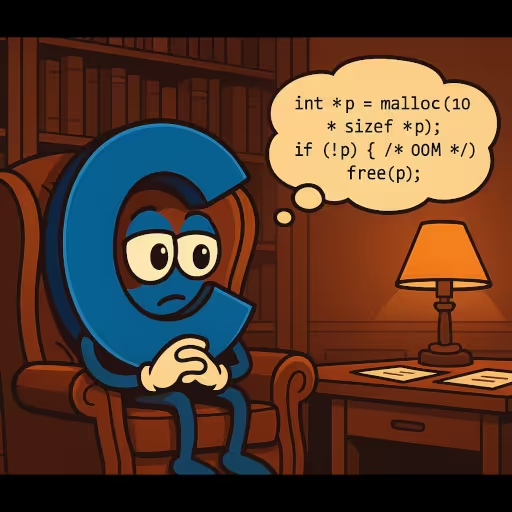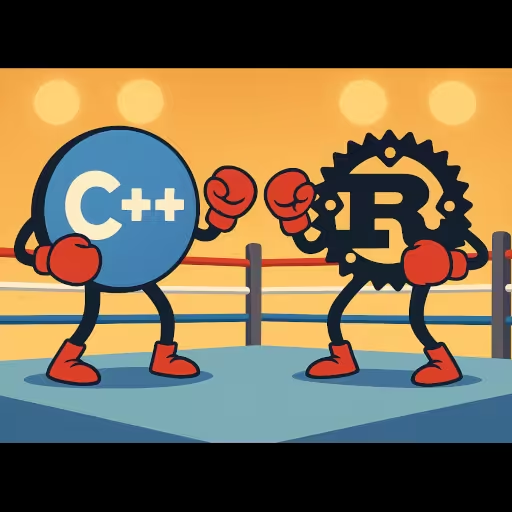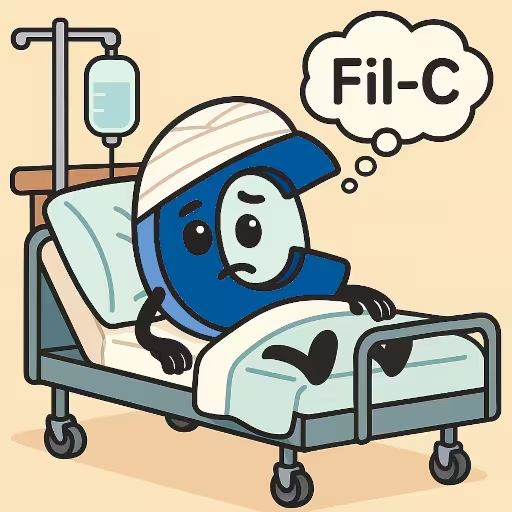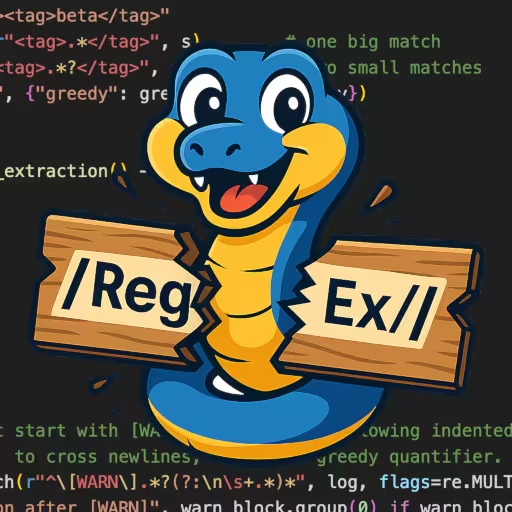C++ Memory Management: Dynamic Memory Allocation in C++
C++ gives you everything C has plus constructors, destructors, exceptions, and templates. That extra power changes how you should allocate, own, and release memory. The headline: prefer RAII and standard containers; treat raw new/delete like power tools—use rarely and deliberately.
If you’re looking for the straight-C perspective, there’s a companion guide you may want next: C Dynamic Memory Allocation: Stack, Heap, and Best Practices — read it here: the C guide.
What Is CPU Memory (in the context of C++)
At runtime your program sees several layers:
- Registers (per core): fastest, tiny.
- CPU caches (L1/L2/L3): small, very fast.
- Main RAM: large, much slower than caches.
- Virtual memory: OS abstraction that backs allocations; page faults are expensive.
⚠️ NOTE: In C++, you don’t directly decide whether a variable sits in a register, cache, or RAM.
Those details are managed by the compiler, CPU, and operating system. What you do control is whether something goes on the stack (automatic storage) or the heap (dynamic allocation), and how your data structures are laid out in memory. That’s why performance-oriented C++ code often emphasizes contiguous storage and RAII over micromanaging hardware details.
Good C++ code keeps hot data contiguous and minimizes allocations. That’s why std::vector<T> (contiguous) usually beats a linked list of T (pointer chasing).
What is L3 Cache?
L3 cache, or Level 3 cache, is a type of memory cache that is used in computer processors to improve performance by reducing the time it takes to access frequently used data. It is typically larger and slower than L1 and L2 caches but plays a crucial role in enhancing the overall efficiency of a CPU.
Check out our other article on C++ performance and L3 cache for more information.
Memory Management C++
C++ has three primary lifetimes:
- Automatic storage (stack) — variables created with block scope.
- Dynamic storage (heap) — objects created with
new(or by containers/allocators). - Static storage — globals and
staticobjects.
The C++ difference: objects have constructors and destructors. RAII (“Resource Acquisition Is Initialization”) binds lifetime to scope so resources are released automatically:
struct File {
std::FILE* f{};
explicit File(const char* path) : f(std::fopen(path, "rb")) {}
~File() { if (f) std::fclose(f); } // auto-cleanup
};No manual close() call scattered around; scope exit guarantees cleanup—even on exceptions.
Here’s a stronger and more complete version of that section — it hits the keyword “what is CPU memory (in the context of C++)”, but also takes a step back to explain what memory is and why it matters before drilling into the stack/heap/caches distinction.
What Is CPU Memory (in the Context of C++)
When people talk about CPU memory, they’re really talking about the layers of storage that your program uses to hold data while it runs. At the most basic level, computer memory is a set of electronic storage cells that keep track of numbers, characters, and instructions so the processor can work on them. Without memory, the CPU would have nothing to load, modify, or execute — every variable in your C++ program, from an int counter to a giant std::vector, must live somewhere in memory.
The Layers of CPU Memory
Modern CPUs don’t treat memory as one big pool. Instead, there are layers, each with different trade-offs in speed and capacity:
- Registers — These are tiny, ultra-fast storage cells inside the CPU itself. They hold immediate values for arithmetic and control. A C++ expression like
a + btypically uses registers under the hood. - CPU caches (L1, L2, L3) — Small but very fast memory banks close to the CPU cores. Caches keep frequently accessed data ready to avoid the long trip to main memory. Cache efficiency is why data structures like
std::vector<T>(contiguous in memory) usually outperform pointer-heavy structures like linked lists. - Main RAM (system memory) — Large and flexible, but slower than caches. This is where most of your program’s data structures actually reside. Both the stack and the heap live here, carved out and managed by the operating system.
- Virtual memory — An abstraction layer that lets each process think it has a giant, continuous memory space. The OS and hardware handle mapping that to physical RAM or even disk storage. Page faults (when data has to be swapped from disk) are very expensive.
Why C++ Developers Care About CPU Memory
In C++, you have more direct control over where and how data is stored than in higher-level languages. Understanding CPU memory helps you:
- Write faster code — Choosing a contiguous structure like
std::vectorinstead of a pointer-basedstd::listcan drastically improve cache locality and reduce pointer chasing. - Manage lifetimes safely — Knowing when to use stack (automatic) vs. heap (dynamic) memory is key to avoiding leaks, crashes, and undefined behavior.
- Design efficient systems — High-performance domains like games, real-time graphics, and finance often revolve around minimizing cache misses and allocations.
In short, CPU memory is the workspace your C++ code depends on. The better you understand its layers, the more effectively you can manage resources and performance.
Stack vs Heap in C++
Now that we’ve looked at the layers of CPU memory — from registers and caches all the way out to main RAM — it’s time to zoom in on the two regions you’ll work with most as a C++ developer: the stack and the heap. These aren’t different kinds of hardware, but rather two ways your program carves up system RAM. The way they allocate and free memory is very different, and understanding that difference is key to writing safe, efficient C++ code.
When we talk about stack and heap memory in C++, we’re really zooming in on two specific regions inside your program’s main RAM. They both live in system memory, but the way they’re managed is completely different — and that difference impacts performance, safety, and design choices in your code.
The Stack: Automatic and Scoped
The stack is a region of memory managed automatically by the compiler. Every time a function is called, its local variables are pushed onto the stack. When the function returns, those variables are popped off, and the memory is instantly reclaimed.
- Speed: Stack allocation is nearly free — it’s just moving a pointer.
- Lifetime: Tied strictly to scope. Once a function exits, its local variables are gone.
- Use cases: Small, short-lived objects where you know the size at compile time.
Example:
void foo() {
int x = 42; // stored on the stack
std::array<int, 10> a{}; // fixed-size buffer, also stack
} // x and a vanish automatically here⚠️ Pitfall: You cannot safely return a pointer or reference to a stack variable; it will dangle after the function exits.
The Heap: Dynamic and Manual
The heap is memory you request explicitly at runtime. In C++ this usually happens through new, std::make_unique, std::make_shared, or containers like std::vector that manage heap allocations internally. Heap objects live until you explicitly release them (or until their owning RAII wrapper does).
- Flexibility: Sizes can be decided at runtime, and objects can outlive the scope they were created in.
- Cost: Slower than the stack, because the runtime allocator has to find and manage free blocks of memory.
- Use cases: Large or variable-sized objects, or data that must persist across function boundaries.
Example:
auto ptr = std::make_unique<int>(99); // allocated on the heap
std::vector<int> nums(1000, 0); // heap buffer managed by vector⚠️ Pitfall: Manual new/delete is error-prone (leaks, double frees). Prefer smart pointers and containers that clean up automatically.
The Difference Between Stack and Heap Memory in C++
- Who manages it: The compiler manages the stack; you (or RAII helpers) manage the heap.
- Lifetime: Stack memory dies with scope; heap memory persists until explicitly freed.
- Performance: Stack is faster, but limited in size; heap is slower, but flexible and larger.
- Safety: Stack is safe and self-cleaning; heap requires discipline (or smart abstractions) to avoid leaks and dangling pointers.
Practical Rule of Thumb
- Use the stack for small, short-lived objects.
- Use the heap (via RAII or containers) when you need dynamic lifetimes or variable sizes.
- Remember: the difference isn’t just technical — it directly impacts runtime speed, safety, and code clarity in C++.
What Is Heap Memory in C++
Heap memory is dynamically requested at runtime. In idiomatic C++, you rarely touch the raw heap; you ask abstractions to manage it:
- Containers:
std::vector,std::string,std::deque,std::unordered_map, etc. - Smart pointers:
std::unique_ptr,std::shared_ptr,std::weak_ptr. - Memory resources:
std::pmr::polymorphic_allocatorfor custom arenas/pools.
Dynamic Memory Allocation in C++
After understanding the stack and heap, the next logical step is to look at dynamic memory allocation in C++ — how you actually request memory at runtime and decide how long it should live. Unlike the stack, which is automatic, the heap gives you flexibility, but also requires careful management.
Modern C++ strongly encourages developers to prefer owning types (like smart pointers and standard containers) over raw pointers. This approach ensures that memory is tied to object lifetimes (RAII), reducing the risk of leaks or crashes.
// Owning single object
auto p = std::make_unique<Foo>(/*ctor args*/); // unique ownership
// Shared ownership (use sparingly; it's a refcount)
auto sp = std::make_shared<Bar>(/*ctor args*/);
// Dynamic arrays: prefer vector
std::vector<int> a(10, 0); // 10 zeros
a.push_back(42);Why Prefer ‘Owning’ Types?
- Exception safety: Destructors run automatically, even during stack unwinding.
- Fewer leaks and double frees: No need to remember matching
new/delete. - Clearer ownership semantics: Smart pointers and containers make it explicit who owns what.
👉 This shift from raw memory management to RAII is one of the biggest differences between C memory allocation and C++ memory management.
C++ Dynamic Memory Allocation: The Toolbox
Of course, there are still times when you may need to manage memory more directly. This is where raw new and delete come into play. Together, they represent the C++ dynamic memory allocation toolbox, but they should be used with care.
// new/delete: match exactly
Widget* w = new Widget();
delete w;
Widget* arr = new Widget[16];
delete[] arr; // must use delete[] for arraysGuidelines for safe usage:
- Prefer
std::make_unique/std::make_sharedover nakednew. - Never mix allocation APIs — don’t
mallocthendelete, ornewthenfree. - Avoid exposing raw ownership in function signatures; pass by value, reference, or smart pointer instead.
While the raw operators are part of the language, most high-level C++ code doesn’t touch them. Instead, they act as a fallback for very specific cases, like custom allocators or low-level systems work.
👉 Next, let’s explore how RAII patterns and memory resources can make dynamic memory management in C++ even more robust.
Dynamic Memory in C++: RAII Patterns You’ll Actually Use
The real strength of C++ isn’t raw allocation — it’s wrapping allocations in objects that manage their own lifetimes. This is the essence of RAII (Resource Acquisition Is Initialization). Rather than remembering to call delete or close yourself, the destructor does it automatically.
Handle/RAII wrapper for C APIs
A common pattern is to wrap C-style resources in smart pointers with custom deleters:
using SocketHandle = std::unique_ptr<std::remove_pointer_t<SOCKET>, int(*)(SOCKET)>;
SocketHandle sock(::socket(...), ::closesocket); // custom deleter
if (!sock) throw std::runtime_error("socket failed");Here, the socket is automatically closed when the SocketHandle goes out of scope.
Pooled / Arena allocations with PMR
For high-performance code that needs many short-lived allocations, C++17 introduced Polymorphic Memory Resources (PMR). These let you allocate from arenas or pools instead of the global heap:
std::pmr::monotonic_buffer_resource arena;
std::pmr::vector<int> fast(&arena);
fast.reserve(10'000); // cheap bumps from the arenaThis approach avoids fragmentation and makes deallocation trivial — reset the arena and all allocations vanish at once.
malloc C++ (and why you probably shouldn’t use it)
malloc() and free() exist in C++ via <cstdlib>, but they don’t call constructors or destructors. That’s a footgun for non-trivial types:
// UB if T is non-trivial: no ctor/dtor runs
void* raw = std::malloc(sizeof(T));
T* t = static_cast<T*>(raw); // no constructor!
std::free(t); // no destructor!Use new/delete (or better, containers/smart pointers) for objects. malloc is reserved for very specific low-level cases (plain byte buffers, custom allocators, interop), and even then std::aligned_alloc/PMR is usually cleaner.
What You Need to Know About Exceptions
Manual new/delete fails hard under exceptions: any delete you miss during a throw leaks. RAII and smart pointers close that gap because destructors run automatically during stack unwinding. If you insist on manual ownership, use the single-exit cleanup or wrap in a guard object.
Ownership and the Rule of Zero (with Rule of Five when needed)
- Rule of Zero: design types so the compiler-generated special members are enough (because real ownership sits in
std::unique_ptr,std::vector, etc.). - Rule of Five: if your type manages a resource manually, implement/disable all five: copy/move ctor, copy/move assign, and destructor.
struct Image {
std::unique_ptr<std::byte[]> data;
int w{}, h{};
Image(int w, int h)
: data(std::make_unique<std::byte[]>(w*h)), w(w), h(h) {}
// Rule of Zero applies: unique_ptr handles move/copy semantics.
};Common Pitfalls (C++ edition)
- Forgetting
delete[]for arrays created withnew[]. - Mixing allocation families (
new/deletevsmalloc/free). - Dangling pointers after
std::vectorreallocation—don’t store raw pointers into container internals. - Overusing
std::shared_ptrwherestd::unique_ptr(or a value) is cleaner. - Cycles with
shared_ptr(break withstd::weak_ptr). - Allocating per element in tight loops; batch and keep data contiguous.
- Throwing from destructors (almost always a mistake).
Practical Patterns That Scale
- Prefer values. Return big objects by value; move semantics are cheap.
- Embrace
std::vectorandstd::stringfor contiguous storage. - Use
reserve()for predictable growth to avoid realloc churn. - Choose
std::array<T, N>for fixed-size buffers on the stack. - Introduce arenas/pools (PMR or custom) for per-frame or per-request lifetimes.
- Document ownership in APIs: who deletes what. If ownership transfers, pass
std::unique_ptr<T>; if not, passT&orT*non-owning.
Quick Reference: APIs You’ll Reach For
- Owning:
std::unique_ptr,std::shared_ptr(sparingly),std::vector,std::string. - Raw:
new/delete,new[]/delete[](minimize use). - Low-level:
<memory_resource>(PMR), custom allocators,std::aligned_alloc(C++17). - Do not default to:
malloc/freefor objects.
Conclusion
Dynamic memory allocation in C++ isn’t just about calling new and delete. It’s about choosing the right abstraction for the problem: sometimes that’s a std::vector, sometimes a std::unique_ptr, and occasionally raw allocation when you absolutely need control. By leaning on RAII and modern language features, you can write code that’s safer, faster, and easier to reason about than old-school manual management.
C++ isn’t “harder than C” so much as it’s stricter about lifetimes. When you lean on RAII, smart pointers, and containers, memory management gets simpler and safer—even with exceptions and templates in the mix. Keep hot data contiguous, keep ownership obvious, and reach for the heap through an owning abstraction.
If you came here first and want the raw-C angle (with malloc(), calloc(), realloc(), free() details), check the companion post: C Dynamic Memory Allocation: Stack, Heap, and Best Practices.










